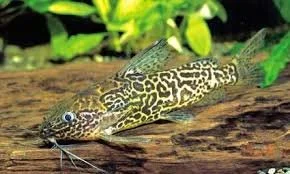 Image 1 of 1
Image 1 of 1


Catfish - Upside down
Species Name: Synodontis nigriventris (Upside-Down Catfish)
Appearance: Upside-down catfish are easily recognizable by their unique swimming behavior - they often swim upside down near the surface of the water. They have a flattened body with a downward-facing mouth, which helps them feed on the algae and other microorganisms that grow on the underside of submerged surfaces.
Tank Requirements:
Tank Size: A minimum tank size of 20 gallons is recommended for a small group of upside-down catfish.
Water Temperature: 72-78°F (22-26°C)
Water Parameters: pH around 6.5-7.5, hardness around 5-12 dGH
Filtration: A good quality filter is important to maintain water quality as upside-down catfish can be sensitive to poor water conditions.
Substrate: Provide a sandy or fine-gravel substrate to mimic their natural environment and to prevent injuries to their delicate barbels.
Behavior: Upside-down catfish are peaceful and social fish that tend to do best when kept in groups of 3 or more. They are known for their unique upside-down swimming behavior, often seen clinging to the surface of the water or the underside of leaves. They are primarily nocturnal, so providing hiding spots like caves, rocks, and plants is essential for their well-being.
Diet: Their diet mainly consists of algae, plant matter, and small invertebrates. You can supplement their diet with high-quality sinking pellets, flakes, and frozen foods like brine shrimp, bloodworms, and daphnia.
Compatibility: Upside-down catfish are generally peaceful and can be kept with other peaceful community fish that share similar water requirements. Avoid keeping them with aggressive or overly active fish that might stress them out.
Breeding: Breeding upside-down catfish can be a bit challenging and is usually not common in home aquariums. However, if you're interested in breeding them, providing them with proper hiding spots, a well-maintained environment, and a varied diet can increase the chances of successful breeding.
Biology: Upside-down catfish (Synodontis nigriventris) are native to African freshwater habitats, specifically in the Congo River Basin. They belong to the family Mochokidae, which is commonly referred to as the upside-down catfish family due to the swimming behavior of many species within this group.
These catfish have specialized adaptations that allow them to swim upside down, such as a modified swim bladder and pectoral fins that are positioned in a way that helps them cling to surfaces. Their unique behavior and appearance make them a fascinating addition to a well-maintained aquarium.
Species Name: Synodontis nigriventris (Upside-Down Catfish)
Appearance: Upside-down catfish are easily recognizable by their unique swimming behavior - they often swim upside down near the surface of the water. They have a flattened body with a downward-facing mouth, which helps them feed on the algae and other microorganisms that grow on the underside of submerged surfaces.
Tank Requirements:
Tank Size: A minimum tank size of 20 gallons is recommended for a small group of upside-down catfish.
Water Temperature: 72-78°F (22-26°C)
Water Parameters: pH around 6.5-7.5, hardness around 5-12 dGH
Filtration: A good quality filter is important to maintain water quality as upside-down catfish can be sensitive to poor water conditions.
Substrate: Provide a sandy or fine-gravel substrate to mimic their natural environment and to prevent injuries to their delicate barbels.
Behavior: Upside-down catfish are peaceful and social fish that tend to do best when kept in groups of 3 or more. They are known for their unique upside-down swimming behavior, often seen clinging to the surface of the water or the underside of leaves. They are primarily nocturnal, so providing hiding spots like caves, rocks, and plants is essential for their well-being.
Diet: Their diet mainly consists of algae, plant matter, and small invertebrates. You can supplement their diet with high-quality sinking pellets, flakes, and frozen foods like brine shrimp, bloodworms, and daphnia.
Compatibility: Upside-down catfish are generally peaceful and can be kept with other peaceful community fish that share similar water requirements. Avoid keeping them with aggressive or overly active fish that might stress them out.
Breeding: Breeding upside-down catfish can be a bit challenging and is usually not common in home aquariums. However, if you're interested in breeding them, providing them with proper hiding spots, a well-maintained environment, and a varied diet can increase the chances of successful breeding.
Biology: Upside-down catfish (Synodontis nigriventris) are native to African freshwater habitats, specifically in the Congo River Basin. They belong to the family Mochokidae, which is commonly referred to as the upside-down catfish family due to the swimming behavior of many species within this group.
These catfish have specialized adaptations that allow them to swim upside down, such as a modified swim bladder and pectoral fins that are positioned in a way that helps them cling to surfaces. Their unique behavior and appearance make them a fascinating addition to a well-maintained aquarium.






